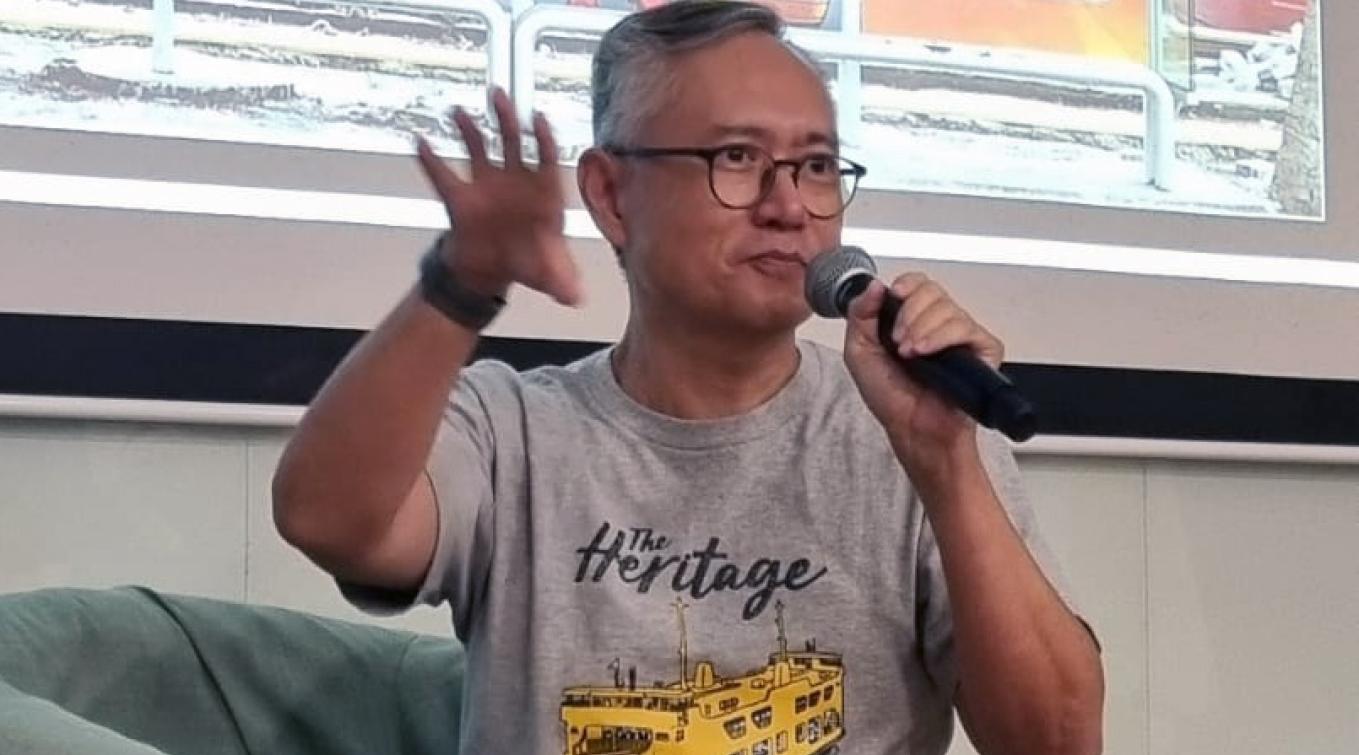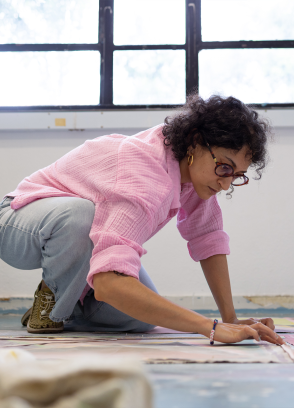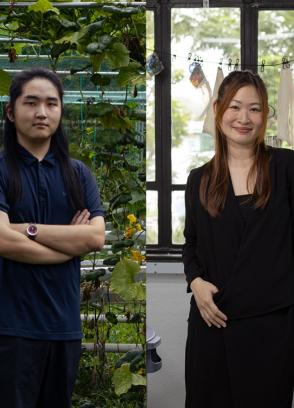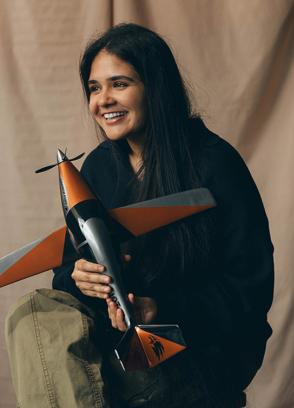Interview by Chris Shaw, Head, Puttnam School of Film & Animation.
A guest speaker at this year’s Making Animation symposium was Julian ‘Lefty’ Kam, a distinguished comic book artist and cultural documentarian. With over 25 years of experience in the comic industry, Lefty has worked across Malaysia, Singapore, Shanghai and the United States, serving in key roles such as editor-in-chief of Left Pocket Creatives in Shanghai and as a lecturer and course planner at The One Academy in Penang.
Lefty is perhaps best known for his ability to blend graphic storytelling with cultural heritage documentation. His work includes the Marking George Town steel rod sculpture series, the Pulau Tikus Community Stories bus stop art, and the Butterworth Heritage Interpretation panels. Through these and many other projects, he has turned comics into a living archive of Malaysian history and everyday life.
His long-term undertaking, Sama-Sama: A Multicultural Art Journey, reflects his commitment to celebrating Malaysia’s multicultural heritage. By collaborating with cultural practitioners and adopting a multisensory, site-specific approach, Lefty brings to light the intangible connections that shape our diverse communities.
Beyond heritage-focused projects, Lefty is also the founder of Gilamon Studio and the creator of the acclaimed comic series Major Zombie, which won multiple awards and has been featured at international conventions. His documentary comics, combining elements of journalism, biography and sequential art, have been exhibited internationally from Taiwan to Hong Kong, and continue to inspire audiences across generations.
At the heart of his work lies a profound love for Penang and for Malaysia’s harmonious way of living. His comics capture not just images, but memories, traditions, and stories, making them powerful vessels for cultural preservation.
On career and creative journey
Chris: You’ve worked in Malaysia, Shanghai, Singapore and the US, how have these different environments shaped your approach to comics and storytelling?
Lefty: Each country has its own requirements, local elements and language, so I approach every environment with preparation, respect and a willingness to collaborate with local talents. Immersing myself in those contexts helps the work feel authentic.
At the same time, the foundation of a good story never really changes; it’s the universal part of storytelling. What differs is how you package and present it so it speaks to each audience in their own cultural language.
Chris: You’ve balanced being an artist, editor and lecturer. How have these roles informed one another in your practice?
Lefty: These roles complement one another and make the creative process more fluid. Because I’m familiar with each area, I can move between them with less overlap and greater clarity. At the same time, I recognise that I can’t, and shouldn’t, do everything alone. For example, when I’m writing a story, I still need an editor to challenge my ideas and keep me on track, just as I do when I edit for others.
Teaching also sharpens this cycle, because explaining concepts to students often deepens my own understanding. Together, these roles create a system of checks, balances and continuous learning in my practice.
On cultural documentation
Chris: Much of your work, such as Sama-Sama and I Am Home, documents Penang’s heritage. How do you decide which aspects of culture or memory to preserve through comics?
Lefty: After conducting extensive research, I usually create a list of significant themes or topics that emerge. I then discuss these with research scholars to ensure I’m approaching them with accuracy and sensitivity. From there, I decide which elements to highlight, based not only on their cultural importance but also on their potential to resonate emotionally with readers. That way, what I choose to preserve through comics is both meaningful and engaging.
Chris: You’ve often said that comics can succeed where photography or archives fall short. Can you expand on why sequential art is such a powerful tool for cultural documentation?
Lefty: Sequential art allows readers to visualise a story in ways that photography or text alone can’t. Unlike static images, comics create a sense of movement and continuity, the story comes alive and unfolds in the reader’s mind. It’s also more immersive than pairing text with pictures, because the two are inseparable in this medium. In a way, comics animate themselves within the imagination of the audience, offering both the depth of literature and the immediacy of visuals, and best of all, without the cost of full animation.
On process and collaboration
Chris: Your projects often involve collaboration with ethnographers, historians and fellow artists. How do these collaborations enrich your work?
Lefty: Collaborating with specialists such as ethnographers and historians brings valuable layers of insight, grounding the work in depth and context that I couldn’t achieve alone. When it comes to fellow artists, I often seek out those whose styles are very different from mine. It’s a way of experimenting, seeing how contrasting voices and approaches can merge to create something unexpected and fresh. These collaborations not only enrich the project but also expand my own perspective as an artist.
Chris: You’ve also mentioned adopting a “multisensory approach” in your art. Could you describe how sound, smell or other senses influence your visual storytelling?
Lefty: A multisensory approach helps deepen and enrich the storytelling. I try to translate my own experiences, whether it’s the atmosphere of a place, the sound of a street, or even the scent of food, into words and sequential art. The goal is for readers to connect those cues with their own memories and senses, so they don’t just see the story, but also feel it. In that way, the work becomes more immersive and personal.
On challenges and opportunities
Chris: What are some of the biggest challenges of sustaining a career in comics in Malaysia, especially when balancing commercial work with passion projects?
Lefty: Unfortunately, meaningful projects never come as often as we’d like, so it’s necessary to take on more commercial work to sustain a livelihood. This challenge isn’t unique to Malaysia. Being a graphic novelist is difficult anywhere in the world. I’m grateful, though, that I can still remain within the creative field, without having to step into something unrelated just to support my family. That balance, even when it leans toward commercial work, allows me to keep my identity as an artist intact.
Chris: How do you navigate the tension between preserving tradition and embracing modern, even digital, tools for your comics?
Lefty: I have nothing against new technology. In fact, I find it fascinating to see how it reshapes the creative landscape. I believe artists should explore with an open mind, testing different tools and approaches. The key is to choose methods that enhance and elevate your work, pushing you further, rather than relying on them as a shortcut. Technology should be a partner in creativity, not a crutch.
On influence and inspiration
Chris: Your influences range from Frank Miller to Moebius to Sergio Toppi. How do you balance inspiration from international comic legends with your own uniquely Malaysian voice?
Lefty: Like with any of my research subjects, I study the works of the artists who inspire me, especially those whose styles resonate with me. I let their influence sink in and become part of my creative system. When I’m working, what I’ve absorbed naturally emerges to help resolve artistic challenges.
The key is not to imitate for imitation’s sake. That only distances you from discovering your own voice. Instead, it’s about allowing those inspirations to guide you while you continue shaping a style that is uniquely your own.
Chris: Looking ahead, what stories or communities do you most want to explore through your future projects?
Lefty: At this point, I’m most interested in continuing to observe grassroots communities wherever I go, paying attention to the small details of daily life that often go unnoticed. My aim is to document subjects that risk disappearing in the tides of progress, so that their stories and memories can be preserved and shared through comics even after they fade away.
Chris: Thank you, Lefty, for taking the time to share your journey and perspectives with us. Your reflections on storytelling, culture, and collaboration have been extremely inspiring. It’s been very insightful to learn how you weave your art with heritage, and how you continue to push the boundaries of what comics can achieve.
I’m certain our students, faculty, and the wider community will draw great value from your sharing, and we look forward to seeing how your future projects continue to shape and preserve cultural narratives.




